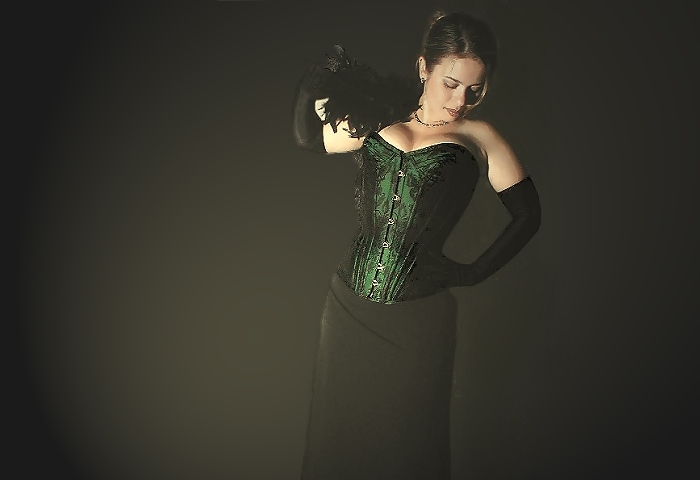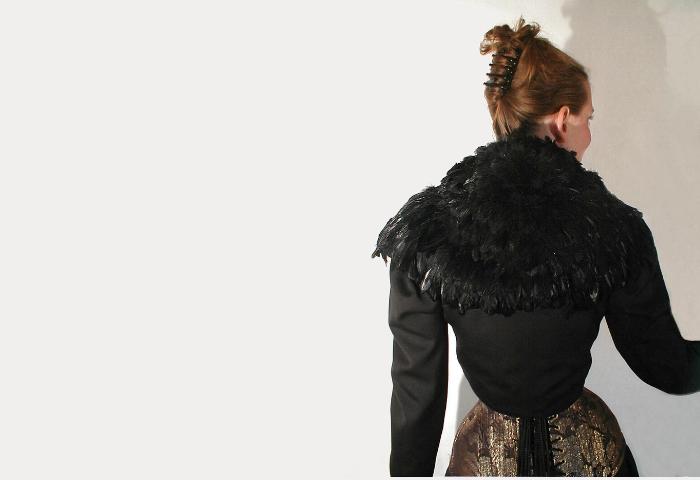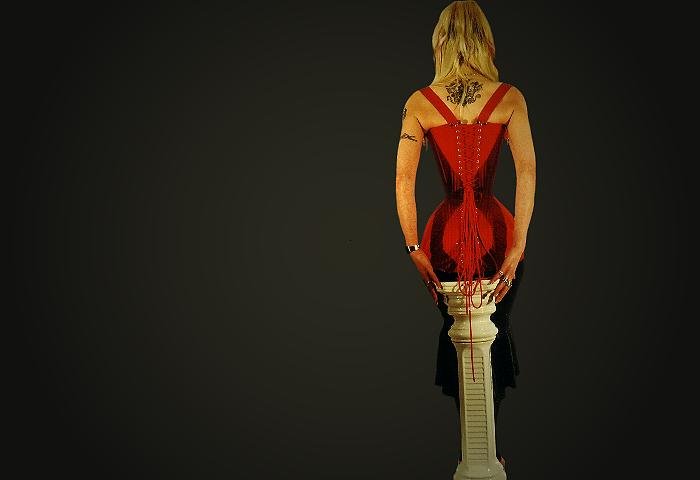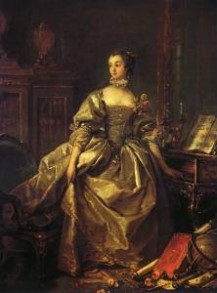History of Corsets - An Overview through the Centuries (1 of 3)
Prologue
This short overview tells you about the origin and the evolution of the Corset through the past centuries up to today . Of course, that can only be done in connection with a view on the general fashion in the particular century and its relation to society. However, we can only give a short description, reduced to the absolute necessities. At all times and under every form of political or social situation, fashion created its local specialities, variations with a more or less short lifetime or special appearance in public. In short, fashion was and is much more complex than can be described here with this text. This is true especially for the 19th century, with its extremly high number of stylistic variations. Here we can give you a very rough overview of tendencies only.
You may wonder about the fact that we cannot show pictures of corsets in early times. The reason is quite simple: they do not exist! Artists did not paint their models, mostly ladies of high society, showing their underwear. Existing well-preserved or renovated original pictures with the subject 'undergarment' or 'corset' are from early 18th century. Our knowledge of corsets from those early days is based on written documents or indirect conclusions from pictures or analysis of fragments of textiles. Therefore the expression 'we know' is an exaggeration; but we can 'reasonably assume' how things may have been.
Old Times - The Ancient World
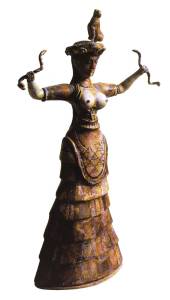 To come to the point: corsets did not exist in those days! We have neither physical evidence nor a written text or any other proof for something that deserves that description. What we know about these former civilizations and their societies is that some of them aspired to small waists as an ideal, expressing it in their art. Best known is the minoic civilization, based on Crete (a beautiful greek island) between 3000 and 1400 BC.
To come to the point: corsets did not exist in those days! We have neither physical evidence nor a written text or any other proof for something that deserves that description. What we know about these former civilizations and their societies is that some of them aspired to small waists as an ideal, expressing it in their art. Best known is the minoic civilization, based on Crete (a beautiful greek island) between 3000 and 1400 BC.
A lot of pictures and statues from that minoic period give us the strong impression that ladies used a kind of body-shaper or the waist had been laced using a different method. We do not know. The old poets, Homer for instance, had been much more interested in the weapons of the men than in the ladies underwear.
During the following Greek civilization, small-waist accentuated clothing had been in vogue, but not as tight as formerly on Crete.
The Greeks were followed by the Roman Empire as the leading force in political, military and cultural aspects around the (known) world. With their calm, purposeful and pragmatic way of life, the Romans dressed themselves with a Tunica or Toga in a simple way. However, some ladies used a kind of bra, made of strips of textile.
Later on, approximately at the time of Julius Caesar (and Asterix) the high society started to appreciate expensive pomp, but more expressed by the use of gold and jewellery than with sophisticated styles for dresses.
Knights and Courtly Love - The Middle Ages
 The Corsets are still not yet available. Nevertheless, the medieval times are very interesting for the history of that garment. On one hand, the art of armour-forging improved dramatically and breastplates were, more or less, the models for the first corsets (the french word ‘corset’ had originally the meaning ‘breastplate’). On the other hand, with the beginning of the 12th century, real "Lady's Fashion" appeared in Europe, with changing elements of styles. No doubt, this happened within the high society or aristocracy only. The mass of the people could not participate and were separated by laws (strict regulations on what kind and colour of clothes is acceptable to be worn by what person with what level in the society and what profession) - and that was valid for the following centuries, too.
The Corsets are still not yet available. Nevertheless, the medieval times are very interesting for the history of that garment. On one hand, the art of armour-forging improved dramatically and breastplates were, more or less, the models for the first corsets (the french word ‘corset’ had originally the meaning ‘breastplate’). On the other hand, with the beginning of the 12th century, real "Lady's Fashion" appeared in Europe, with changing elements of styles. No doubt, this happened within the high society or aristocracy only. The mass of the people could not participate and were separated by laws (strict regulations on what kind and colour of clothes is acceptable to be worn by what person with what level in the society and what profession) - and that was valid for the following centuries, too.
During the gothic period (14th century), long and slim shapes had been "in" - not only for steeples but for people too. Ladies used to wear long and tight fitting clothes. Some experts speculate on very vague hints, that bandages had supported the visible slimness. That's quite reasonable, because female vanity existed at all times. However, no proven evidence is available.
At the end of the 15th century, front-laced bodices occurred, stiffened with strengthened fabric and sometimes even with wires of brass.
The First Period of Corsets - The Renaissance (16th Century)
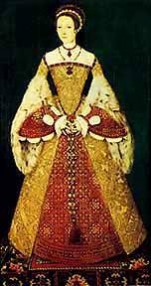 The French word "Renaissance" means rebirth and is used for the regeneration of knowledge from the time of antiquity and, in some countries, pushing back religious restrictions, which had obstructed some cultural developments. But the antique style of fashion did not occur again. Instead, the richly decorated and highly expensive renaissance gowns were tailored using the finest fabrics, partly imported from far away (Chinese silk or East-European furs!), partly manufactured with newly developed techniques of weaving and colouring. Of course, this expensive fashion was once again only available for the upper class. The extraordinary pomp had to be demonstrated in public, by ladies and gentlemen. During those days, ‘iron’ was the leading mens' fashion for official purposes. The gentleman as representative of the ‘upper class’ preferred a highly polished and artificially decorated breastplate to demonstrate this. In Spain, at this time one of the leading states in Europe, this style of official fashion was taken over by the High-Society-Ladies. They didn't use an iron breastplate, but they shaped their silhouette in similar way by a stiff garment made of fabrics to have the same figure of high dignity - the corset was born.
The French word "Renaissance" means rebirth and is used for the regeneration of knowledge from the time of antiquity and, in some countries, pushing back religious restrictions, which had obstructed some cultural developments. But the antique style of fashion did not occur again. Instead, the richly decorated and highly expensive renaissance gowns were tailored using the finest fabrics, partly imported from far away (Chinese silk or East-European furs!), partly manufactured with newly developed techniques of weaving and colouring. Of course, this expensive fashion was once again only available for the upper class. The extraordinary pomp had to be demonstrated in public, by ladies and gentlemen. During those days, ‘iron’ was the leading mens' fashion for official purposes. The gentleman as representative of the ‘upper class’ preferred a highly polished and artificially decorated breastplate to demonstrate this. In Spain, at this time one of the leading states in Europe, this style of official fashion was taken over by the High-Society-Ladies. They didn't use an iron breastplate, but they shaped their silhouette in similar way by a stiff garment made of fabrics to have the same figure of high dignity - the corset was born.
These first corsets were made of fabrics or leather with sewed in pieces of wood or metal to create the necessary stiffness. These stiffeners had the function to support the body (not the bust) and to symbolize by its hardness and stiffness the stand-offishness of the Lady, very similar to the armour of her husband (which was more a symbol than a protection, too, because firearms were already being used). This corset-design was not meant to create a small waist or accentuated raised breasts. On the contrary, the fashion asked for "no-bust", the bust had to be pressed flat. A lady's highly stand-offishness excluded maternal curves. Matching the corset, a stiff conical hoop-skirt was in vogue. This underwear had a triple function: to display a maximum of fabric as an expression of wealth, to create a certain distance to other (lower class) people and, visually, to give the impression of an accentuated waist. It's quite sure that this fashion created some of the most uncomfortable garments women ever wanted to endure.
The Tudor fashion-style in England was very much influenced by the fashion of the Royal Court of Spain and was very similar in the elements of style. Austria, like Spain a part of the Empire of Habsburg, was influenced by the Spanish ideas of fashion, too, as well as the Netherlands. The courts in France, Germany and Italy preferred a less stiff line than the Spanish. In France people preferred obviously wide hips. They created an extra wide hoop-skirt, the so-called "panier".
In the time of late Renaissance, Elizabeth I was Queen of England. She gave the name to the fashion of the time as "Elizabethan Style", developed from the Tudor style. It was less rigorous and accentuated a small-laced waist. But the waist-reduction was not yet created by the corset itself, but by a laced bodice or by bandages.

History of Corsets - An Overview through the Centuries (2 of 3)
Things tighten up - Baroque period (17th Century)
The period of early Baroque shows a wide range of national differences in ladies court-fashion. In countries under the influence of the house of Habsburg, the corset remained very stiff up to the middle of the century, but lighter material was used (preferably whalebone) and the manufacturing technologies improved significantly. In addition, a little bit more space for the breasts was given. The hoop-skirts now were barrel-shaped (this style came from France) and had a circumference up to 5 metres.
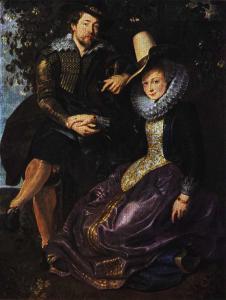 The Netherlands (under Spanish influence) had a special fashion, too. Up to the end of that century fashion asked for very strict, high-neck gowns. High Society regulation on behaviour expected that a lady's feet never should be seen. Remember an expression of Isabella of Castile: 'a Queen of Spain has no feet!' (rejecting a gift [stockings] from the king of France).
The Netherlands (under Spanish influence) had a special fashion, too. Up to the end of that century fashion asked for very strict, high-neck gowns. High Society regulation on behaviour expected that a lady's feet never should be seen. Remember an expression of Isabella of Castile: 'a Queen of Spain has no feet!' (rejecting a gift [stockings] from the king of France).
In other European countries more easy-going dresses with a lot of lace were fashionable. Hoop skirts had fallen out of favour, instead, bolsters on the hips were used. France became, based on its absolutist monarchy and the splendid royal court, the leading nation in any respect on questions of fashion. Corsets were used for tight-lacing now, especially in France. To get the expected straight front, a rod, made of wood or metal (or sometimes a dagger), was inserted into a vertical pocket of the corset, just in front of the breastbone.
If the matter became too uncomfortable (for instance at an opulent dinner - very polular in baroque) this rod could be taken out. Such a part was named in German 'Blankscheit' (= 'shiny rod'), which became "Planchette" in French. This French word is still in use today and describes a strong rod of stiff spring steel underneath the front busk hooks and eyes of a corset (not needed for every corset, but only if enhanced stiffness of the front is needed).
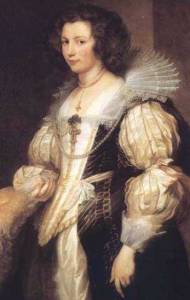 By the early 17th century, an important change took place: women were allowed to carry out the craft of tayloring. They were certainly more familiar with the needs and wishes of their female clients - especially if it concerned undergarments. Another innovation during this epoch was that specialists in the taylors guild appeared, who solely produced laced bodices and corsets.
By the early 17th century, an important change took place: women were allowed to carry out the craft of tayloring. They were certainly more familiar with the needs and wishes of their female clients - especially if it concerned undergarments. Another innovation during this epoch was that specialists in the taylors guild appeared, who solely produced laced bodices and corsets.
Balls and Mistresses - The Period of Rococo (18th Century)
The word ‘Rococo’ is the modified French word ‘Rocaille’ and describes a playful, shell-shaped decoration on buildings. Nearly everything was more ‘easy’ and playful now.
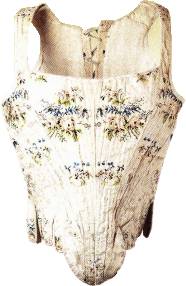 |
The corsets, too, ceased to have a straight front and were used to show all parts of the female torso in the best light. The absolutist monarchy and its display of splendour reached its summit (which preceded its end). Corsets manufactured in this period were mostly sophisticated, expensive masterpieces. To get the expected stiffness, a large number of relatively thin whalebones (sometimes up to 100 pieces) had been sewn in. |
Valuable fabrics were used as outer material and corsets became sometimes part of the outer garment. The design called for shoulder-straps and the hip-part was made in such a way that a smooth transition to the again fashionable hoop-skirts was achieved. The new types of hoop-skirts (different styles during the rococo, the 'panier'-style being the best-known) had sometimes really ‘royal’ dimensions, up to 7 metres circumference. The tightly-laced waist appeared unbelievably small in them.
|
|
The corset of a distinguished lady was laced at the rear in general, because she had her maid constantly available. Front busk-hooks (in the design of today) were not available, so for each dressing of her ladyship the whole lace had to be threaded and laced. Common people made do with more simple and less expensive stays without supporting whalebones, and lacking a maid, with front-lacing. Many national or regional costumes have their origin in these times. |
Revolution and Napoleon - the Period of Empire (1789 - 1815)
The absolutist monarchy in France had overstepped the mark. The French revolution broke out and ended in the declaration of the republic. The guillotine decapitated the Royal Family, including the famous tight-lacer Queen Marie-Antoinette. Everything which had something to do with aristocracy was tabooed. That included corsets, too.
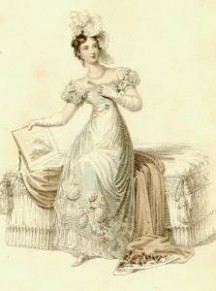 In the following time and also under the reign of Napoleon I, the Empire-style got accepted in ladies fashion. It is distiguished by a waistline just underneath the bust and a straight long skirt. Corsets of the old style were not worn with that. Predecessors of this style had already come in vogue in England around 1770. The english upper class appreciated a easy-going 'countryside' style. But nevertheless, corset manufacturers did not become unemployed. The fashion of empire asked for very separated breasts. The corset-tailors followed this ideal with the so called divorce corset, which may be described as an early but very uncomfortable bra. Based on the leadership of France in questions of fashion, the Empire-style was taken over to other European countries, too. But in England, which was independent from Napoleon, the style was a bit more playful as in the rest of Europe, and the fashion without corsets had only a short lifetime. Additionally the 'Dandy-Look' of gentleman's fashion was created there. This fashion was 'in' up to the 4th decade of that century (the 'dandy' meanwhile became a 'beau'). The dandy-look asked for a slim waist (to make shoulders appear much wider), which meant that gentlemen were now wearing corsets, too. Mostly short waist-cinchers were used.
In the following time and also under the reign of Napoleon I, the Empire-style got accepted in ladies fashion. It is distiguished by a waistline just underneath the bust and a straight long skirt. Corsets of the old style were not worn with that. Predecessors of this style had already come in vogue in England around 1770. The english upper class appreciated a easy-going 'countryside' style. But nevertheless, corset manufacturers did not become unemployed. The fashion of empire asked for very separated breasts. The corset-tailors followed this ideal with the so called divorce corset, which may be described as an early but very uncomfortable bra. Based on the leadership of France in questions of fashion, the Empire-style was taken over to other European countries, too. But in England, which was independent from Napoleon, the style was a bit more playful as in the rest of Europe, and the fashion without corsets had only a short lifetime. Additionally the 'Dandy-Look' of gentleman's fashion was created there. This fashion was 'in' up to the 4th decade of that century (the 'dandy' meanwhile became a 'beau'). The dandy-look asked for a slim waist (to make shoulders appear much wider), which meant that gentlemen were now wearing corsets, too. Mostly short waist-cinchers were used.
The history of the corset - an overview (3 from 3)
The Big Time of Corsets - The 19th Century
Napoleon had his Waterloo and France had its aristocracy come back. Was that an advantage for the french people? Well, it was doubtless an advantage for the corset-makers. "Back to the good old times" was the slogan.
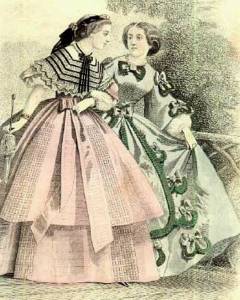 The bourgoise women wore the victorian fashion (named after Queen Victoria of England who reigned from 1837 - 1901): high neck tops and wide skirts. The gowns worn at the balls of the aristocracy and the upcoming money-aristocracy were less chaste. They resembled very much the fashion of Rococo (having less ribbons, though), which is why the epoch is called the second Rococo. Queen Elizabeth of Austria (nickname "Sissi") lived in this period and she was well known for her ambition concerning a tight waist, similar to the Empress Eugenie of France. Also the romantic fashion in the Southern States of America before the civil war (before it was "Gone with the wind"), is part of the second Rococo.
The bourgoise women wore the victorian fashion (named after Queen Victoria of England who reigned from 1837 - 1901): high neck tops and wide skirts. The gowns worn at the balls of the aristocracy and the upcoming money-aristocracy were less chaste. They resembled very much the fashion of Rococo (having less ribbons, though), which is why the epoch is called the second Rococo. Queen Elizabeth of Austria (nickname "Sissi") lived in this period and she was well known for her ambition concerning a tight waist, similar to the Empress Eugenie of France. Also the romantic fashion in the Southern States of America before the civil war (before it was "Gone with the wind"), is part of the second Rococo.
Corsets in this time were laced down to the waist only, because below the waist, petticoats or hoop-skirts (called crinolines in these times) defined the silhouette. These crinolines had, like in Rococo, tremendous circumferences. Until the middle of the century not only the waist, but also the lower chest were laced tight. The corsets had a shape we would call "stem waist" now, and elaborate bust-cups. New front closing mechanisms were developed, but up to 1845 they were an exception.
 In the middle of that century, the industrial revolution started and changed not only the society, but the fashion and of course the corsets too. Steel goods got cheaper, stainless steel was developed and so the expensive whalebones could be replaced by wires, steel-busks, steel springs and other steel goods. Corsets got more and more "technical": the front-fastening mechanism finished the dull fiddling of laces into the eyelets and mechanically inserted metal-eyelets were introduced. This was great progress. Before, the eyelets had to be (manually!) hemmed with thread. The durability of these very expensive corsets was certainly quite limited. With the technical progress (since 1846 sewing-machines were available), the corset became a mass product. Anyone who wasn't really poor could afford one. And almost all women bought them. In the area of Stuttgart alone, about 6000 corset-makers worked in 1860. Nevertheless, don't think that there were hosts of extremly tightlaced women. The woman in the street used the corset mainly to support the breasts and other maternal round-ups. It gave a housewife with six children (quite common at that time) the chance to keep a respectable posture. The corset was even a strong symbol for reputation in those days.
In the middle of that century, the industrial revolution started and changed not only the society, but the fashion and of course the corsets too. Steel goods got cheaper, stainless steel was developed and so the expensive whalebones could be replaced by wires, steel-busks, steel springs and other steel goods. Corsets got more and more "technical": the front-fastening mechanism finished the dull fiddling of laces into the eyelets and mechanically inserted metal-eyelets were introduced. This was great progress. Before, the eyelets had to be (manually!) hemmed with thread. The durability of these very expensive corsets was certainly quite limited. With the technical progress (since 1846 sewing-machines were available), the corset became a mass product. Anyone who wasn't really poor could afford one. And almost all women bought them. In the area of Stuttgart alone, about 6000 corset-makers worked in 1860. Nevertheless, don't think that there were hosts of extremly tightlaced women. The woman in the street used the corset mainly to support the breasts and other maternal round-ups. It gave a housewife with six children (quite common at that time) the chance to keep a respectable posture. The corset was even a strong symbol for reputation in those days.
Very tight-laced corsets belonged to the festival- and evening-fashion of "high" society, which now included the rich citizens too. And of course, there were fashion-conscious ladies, who always and everywhere wanted to look perfect and therefore tight-laced even in their day costumes.
After the "stemwaist"-period (from middle of the century), the corsets became shorter in the waist. The "hour-glass"-silhouette was born, nowadays known as the Classic- (or Victorian-) corset-style. The corset became actually a bit more comfortable by that. However, it was possible to lace them more tightly than before, and in that case the improved comfort was lost very soon. Between 1860 and 1870, crinolines run out of fashion and were replaced by the ("cul de Paris").The corsets were longer now - and even tighter, because the optical effect of the crinoline did not exist anymore. From 1880 skirts became extremely tight, so shaping of the hips became more and more important, which was achieved with very long corsets.
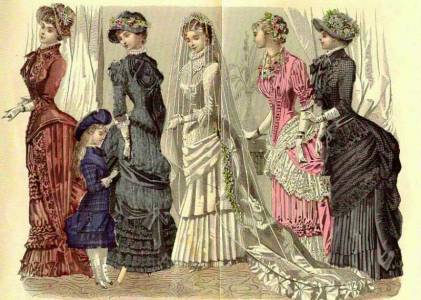
With the change of the century, straight-front corsets became fashionable again (we had this before, didn't we?). They should improve comfort of wearing by decreasing pressure on the stomach area.
Even Gentlemen's fashion was not without corsets. After the dandies, especially army-officers detected the corset as a means to have a dignified, stiff bearing when wearing a uniform. These corsets had not been designed for waist reduction, if it wasn't to flatten a (beer-) belly.
Two World Wars and New Ideologies - The 20th Century
 Concerning comfort, the straight-front corset certainly had its advantages, but was somehow a bit unspectacular. Therefore, corset-designers started to tighten the waist at the sides and subsequently at the backside. The resulting style is called S-line corset, named by the S-shaped spine, enforced by the tight-laced corset. Extreme S-line corsets change motion and posture dramatically: the upper chest is forced forward and the buttocks backward. Only the wider skirts made things easier for the ladies. This fashion lasted until 1910.
Concerning comfort, the straight-front corset certainly had its advantages, but was somehow a bit unspectacular. Therefore, corset-designers started to tighten the waist at the sides and subsequently at the backside. The resulting style is called S-line corset, named by the S-shaped spine, enforced by the tight-laced corset. Extreme S-line corsets change motion and posture dramatically: the upper chest is forced forward and the buttocks backward. Only the wider skirts made things easier for the ladies. This fashion lasted until 1910.
Afterwards, a very small and straight silhouette came in vogue. Corsets continued to be used, but the design became very different to the "classic" style. Now mainly the hips, the bottom and the thighs (yes, really) were corsetted. In this time, the fashion of the 'hobble-skirts', which were very tight at the lower legs, occured, but had only a short life-time.
World War I (1914-1918) finished the big time of the corset, even if the described hip-corsets were still in use until the "roaring 20th". What were the reasons for the decline? Sometimes the 'reform-dresses' are mentioned, wide and very convenient dresses, worn without corsets. They were introduced around the turn of the century and should benefit health. But these dresses were worn by a minority only, and never at important events or other more or less official occasions. They were mostly a casual dress for sports in the open air. Also various warnings about corsets because of assumed health hazards couldn't have been the true reason for the virtual disappearance of corsets. Similar warnings had been given since the Baroque age, but without a considerable effect on corset wearing. The reasons are more complex.
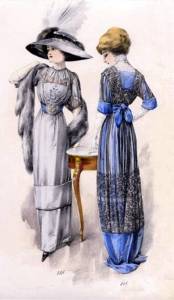 Two subsequent World wars made a majority of european people face other problems than a tight waist. The development of the relatively cheap "bra" (in the present style since 1930) took over one main objective of the corset: the support of the breasts. Additionally, new types of corset-like underwear, made with elastic material (later on named "Corselet") occurred in the market. Last but not least, the hems of the skirts were lifted up to the knees (and that wasn't the limit, as we know). That means, the leg became an eyecatcher and drew attention away from the waist for the time being. In the Fifties, the small waist had a revival, even in "Haute-Couture". In France the "guêpière", a kind of light-weight-corset, was developed and used especially together with show-costumes.
Two subsequent World wars made a majority of european people face other problems than a tight waist. The development of the relatively cheap "bra" (in the present style since 1930) took over one main objective of the corset: the support of the breasts. Additionally, new types of corset-like underwear, made with elastic material (later on named "Corselet") occurred in the market. Last but not least, the hems of the skirts were lifted up to the knees (and that wasn't the limit, as we know). That means, the leg became an eyecatcher and drew attention away from the waist for the time being. In the Fifties, the small waist had a revival, even in "Haute-Couture". In France the "guêpière", a kind of light-weight-corset, was developed and used especially together with show-costumes.
But the idea of emancipation, which spread in the Sixties caused corsets to become taboo. It was now regarded as a symbol for the oppression of women, exactly the same as it had been a symbol for rich and mighty women and a symbol for honourable women. From then on, corsets could only be seen with show-stars, in theaters, as sexy underwear for fetishists and (in the lacquer and leather version) in the red-light-districts or at SM-Parties.
Not until the 80's, did an increasing number of friends and enthusiasts of this garment ( who had always existed) get together. The last corset-makers (mostly located in England) passed on their knowledge to successors, as far as possible, and a small but growing market for corsets of high quality developed. Today there is a greater variety of corsets than ever before. We have an extented range of materials now, and corset styles are produced which wouldn't have been useful in former times. For instance, the under-bust corset is such a recent style (because bras are available now). All the historic corset-styles are sources for the ideas of present corset designers.
The Beginning of a new Millennium - The 21th Century
Times are over when it was a lady's duty to wear a corset, and that's all right. But times are not over when a big part of the "normal" society ostracizes corsets. Nevertheless, it isn't as bad as 20 years ago. Then, a woman had to be very courageous to wear a tight-laced corset in public. Today, it's sufficient if she has a good deal of self-confidence. Corsets even found their way again to the catwalks of the "Haute Couture" in Paris, Rome or New York (status: 2002).
The corset has already symbolized so many things. Maybe in the 21th century it will be a symbol for individualism and finding pleasure {at}in beauty, female beauty in particular.
Corset-shapes and fashion
Time categories and historical evolution
In the range of Victorian-corsets it is particularly not possible to find accurate delimitations because this period would be allowed to embrace 55-65 years. Most appropriate it is described in the lecture 'History of the underwear 1700-1960' which says, that the apparently uniform appearance of fashion may also dissolve after the process of development into short-lived Single-developments from which some became fashion at later times.The different coloured representation below shows three still relevant categories in coloured demarcation. The non gradated periods have rather no more importance, and should be categorized in before or after prevailing categories.
In the following table you will find an overview of the effects, basic cuts and silhouettes of corsets over the decades. A mouse-click on the respective text-link will open a window with commentated illustrations.
1. shaping the body |
3. time-categories and historical evolution |
|---|---|
1.1 Upperbody1.1.1 Unterbrust 1.1.2 Halfbust 1.1.3 Overbust 1.2 Hips and bottom1.2.1 Girdle 1.2.2 Long 1.2.3 Hipsized 1.2.4 Bottomsized 2. Shape types2.1 Hourglass 2.2 Stemwaist 2.3 Ice-Cone 2.4 Wasp-waist |
3.1 1780 Bodice 3.2 1810 Hourglass without boning 3.3 1845 Stay with bust-gussets 3.4 1850 Hourglass with gussets 3.5 1858 Wasp-waist with front-busk-fastening 3.6 1866 Wasp-waist with Bra-gussets, front-fastener and spoon busk 3.7 1878 conical front busk-fastener 3.7 1885 High victorian 3.8 1891 Late victorian 3.9 1898 Late victorian - overbust with strapes 3.10 1900 Straight-Front 3.11 1902 S-Line 3.12 1908 S-Line - stretched (slender bottom) 3.13 1918 Waist-hip-girdle |
Snippets
Opposite to conventional Overbust-Corsets corsets with cups (that means: with integrated bra) offer some clear advantages
Thus an integrated Bra offers the advantage, that a large bossom experiences the necessary support, while in case of a small bossom a 'Push-up'-effect can be made possible. Moreover a complete bust-simulation is also realizable.
 Hidden interests - Crossdressing, TV and Transgender
Hidden interests - Crossdressing, TV and Transgender
Sometimes men also like the feeling of beeing enclosed. Sometimes with, sometimes without urge for female body shape. The appeal of this issue results in the demonstration of a reinforced self-conciousness, but sometimes also to give feminine attributes to the masculine body.
 Bodice or Rokoko-Corset (balleine)
Bodice or Rokoko-Corset (balleine)
The Bodice, also known as rococo-corset is a halfbust-corset. It usually formes the upper body rather than the waist and has its impact on the female chest. It raises the decollete but keeps it flat at the same time.
 Victorian halfbust-corset 'Heather'
Victorian halfbust-corset 'Heather'
The shown Halfbust-corset is a replica of a survived original corset, which was designed and manufactured around 1890. As usual in the 1890's, the original corset had been designed for whalebone stiffeners. Whalebone stiffeners are nowadays not any more available, so they were replaced by metal-rods and implemented into the replica accordingly.
Die Darstellung zeigt das Halbbrust-Korsett 'Crystal' im Viktorianischen Stil, welches im Schnitt und der Stangenführung einer Originalvorlage nachempfunden wurde.
Abweichend vom Original ist in dem dargestellten Korsett zur Ehöhung des Tragekomforts eine Unterplanchette eingearbeitet.
 Victorian Corset at 1890 'Jasmin' (Corset-Replika)
Victorian Corset at 1890 'Jasmin' (Corset-Replika)
The picture at the right shows a replica of a corset originated in the late 80th of the 19. century. The top-layer of this corset was made originally with fabric of black silken satin and the inner layer of light-weight cotton-gabardine.
The corset-model 'Jasmin' is a precise Remake in cut- and line-shape, down to the details.
Decorative Layers
Silk, brocade, satin, leather and vinyl.
All corsets shown on these pages are available with the usual materials as silk, brocade, satin and leather or vinyl. These materials are used specifically for the decorative layer, while the inner-layer of the corsets is made from heavy twill to support the body forming strength. If desired, an additional inner silken lining is possible also.
Most read
- Home
- Bespoken taylored corsets
- Newsletter terms and conditions
- Hidden interests - Cross-dressing, TV and Transgender
- Modern corset-shapes - Wearable and Presentable to the Society
- Corset - Style S-Line
- Corsets and fashion
- Men's Corset-vest 'Amadeo' (for emphasised waist)
- Posture-Corset for Men (Trainings-corset)
- Disclaimer
- Imprint
- The history of the corset - an overview (3 from 3)
- Corset with cups
- Full boned rigid stiff historical Rococo Corset (Balleine)
- Adaptations of Historical Design Elements for up-to date Corset-Fashion

